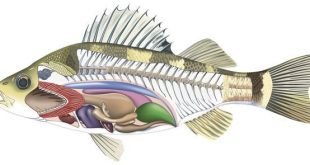Hagfish
In hagfishes, unidirectional water flow through the serial muscular gill pouches is chiefly brought about by rolling and unrolling of velar folds. These lie in a chamber developed from the naso-hypophyseal tract and are operated by a complex set of muscles inserting onto cartilages of the neurocranium. Peristaltic contractions of the gill pouches and their ducts assist in producing the flow. In Myxine, the gill pouches open by a common duct, while in Eptatretus 5–16 gill pouches (according to species) open directly to the exterior.
Since hagfishes feed half-buried in their prey, and since they survive well after the nostrils have been blocked to interrupt gill ventilation, it is clear that cutaneous respiration is important. Indeed, this is indicated by the vast subcutaneous blood sinuses found in hagfishes; the skin is like a loosely fitting sock and if one holds up a living hagfish blood at once flows down to swell the lower end. Blood volume at 180 ml kg –1 is over twice that of gnathostome fishes, and much greater than that of lampreys. Ingenious measurements of resting oxygen consumption by hagfish on the sea bed at 1230 m, using a respirometer mounted on a remotely controlled vehicle, gave average values of only 3.1 mg g–1 h–1. So cutaneous respiration may well suffice for hagfishes at rest, in Myxine the water pumped by the velar folds bypassing the gills.

Lampreys
In the ammocoete larva, the pharynx is undivided, and, unlike the adult, the larva filter-feeds and respires from the same unidirectional inhalent water flow. This is driven partly by the action of the anterior muscular velum, and partly by contractions of the branchial basket brought about by gill muscles. The branchial basket is a continuous cartilaginous meshwork, rather than being jointed, and expands by its elasticity. Valves at the entrance and exit of the gill pouches ensure unidirectional flow during the rhythmic movements of the branchial basket. The possibility for countercurrent flow exists in the ammocoete gill, but this has not yet been demonstrated experimentally, although oxygen extraction rates are about double those of adults where the water flow is tidal.
In the adult, where the mouth and sucker are involved in feeding, the velum is not involved in pumping water (it remains after metamorphosis as a small flap valve), and contraction and expansion of the branchial skeleton pumps water in and out of the gill pouches. The direction of flow is controlled by valves, and is tidal. It obviously has to be tidal when the lamprey is feeding, or moving pebbles with its sucker as it makes its redd to spawn, but it always seems to be tidal even if the lamprey is free-swimming and could inhale through the mouth.

We should expect, therefore, that oxygen extraction would be relatively inefficient in adult lampreys, and, instead of achieving gnathostome fish values, Entosphenus can only manage to extract between 10 and 28% of the oxygen in the inhaled water. Another way of looking at respiratory efficiency is to consider it as the ratio between the amount of oxygen acquired at the gas exchanger available for metabolic purposes, and that used by the respiratory muscles themselves.
Lampreys have a relatively large amount of branchial musculature, so here again, respiratory efficiency seems likely to be low.
 EazyBio: Educate, Elevate, Empower EazyBio: Educate, Elevate, Empower
EazyBio: Educate, Elevate, Empower EazyBio: Educate, Elevate, Empower




